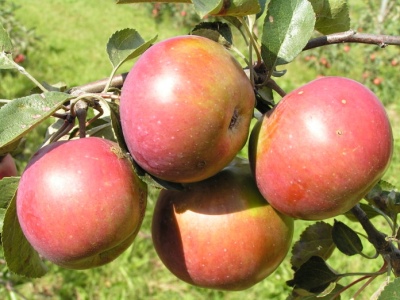
- Authors: Belarus, G.K. Kovalenko, D.V. Grakovich, V.M. Evdokimenko, Z.A. Kozlovskaya, G.M. Marudo
- Taste: sour sweet
- Scent: weak
- Fruit weight, g: 160
- Yield: up to 30 t / ha with a planting pattern of 5 x 3 m on an average rootstock of 54-118
- The beginning of fruiting varieties: on the 2nd, 3rd year after planting in the garden on the rootstock 62-396 and on the 4th, 5th year on the seed stock
- Ripening terms: winter
- Removable maturity: late September-early October
- Keeping quality: up to 165 days
- Duration of the consumer period: November - February
The Vesyalina apple tree can confidently challenge other well-established varieties. But many gardeners are not aware of its capabilities. And this topic must be covered as thoroughly as possible.
Breeding history of the variety
Great Vesyalin culture was created in Belarus. The work on the plant was carried out by a whole team of breeders, among which there are such big names as Kozlovskaya and Marudo. The varieties Joyce, Welsey, Babushkino and Lovefam were taken as a basis. In 2004, a new crop appeared in the register of fruit plants in Belarus. Since 2006 it has been approved for breeding in Russia.
Description of the variety
Features, pros and cons
The height of the Vesyalina apple tree can reach 4 m. It has a rounded expressive crown. The leaves are painted in a pleasant dark green tone. They are distinguished by a matte sheen and a carved edge. Shoots - brownish-red, edged.
Such an apple tree can be grown on:
loamy ground;
podzole;
black soil;
light loams.
Active solar lighting is very important for her. It is also recommended to avoid areas with high standing soil water. The plant is prone to powdery mildew. But with competent agricultural technology, this problem is solved quite effectively. The advantages of Vesyalina can be considered:
steady volume of harvests;
decent commercial characteristics of the fruits;
the regularity of picking apples;
scab resistance.
Ripening and fruiting
The emergence of fruits, as already indicated, occurs systematically. They will form on the ringlets. The stability of the harvest fully compensates for their relatively small size. Vesyalina belongs to winter apple trees. Consumer time is in November, December, January and February. Fruiting, depending on the method of planting, begins at 2-3 or 4-5 years.
Growing regions
Vesyalina is officially zoned for:
middle lane;
the Russian northwest;
western regions of the Russian Federation;
Moscow region.
Yield
The plant does not set records for fertility. Rather, it belongs to the "strong middling". But little will be able to disrupt the normal course of apple formation. Before harvesting, the fruit will not fall off. This circumstance will delight neat gardeners who love to harvest directly from the branch.
Fruits and their taste
When ripe, Vesalin's apples are greenish. Their integumentary part is dark red with some purple inclusions. The fruit itself has a purely rounded or transitional shape from round to conical. Other information is as follows:
ripe apple weight 160 g;
thin, dense peel, covered with a pronounced waxy bloom;
a large number of easily visible subcutaneous points;
white color of the main part of the pulp;
pinkish tint of the pulp that is directly adjacent to the skin;
medium density and very high sweetness of the inner part of the fruit;
tasting score - 4.5 points;
guaranteed keeping quality up to 165 days.

Growing features
Vesyalina loves moisture, but it is not worth "pouring" too much into it. Drought tolerance and resistance to premature frost have not yet been determined. Areas with slightly acidic or neutral soil are preferred. There are no recommendations for shelter for the winter, but you can use the universal measures recommended for all apple trees. There are no other specific tips for cultivating this variety.





Diseases and pests
It is worth noting that Vesyalina does not always resist scab. With a particularly powerful infection, the tree's immune defenses can be breached. Therefore, gardeners need to act carefully and clearly, to take care of the prevention of infection. Among insects, the apple moth is a danger.
Diseases can be dangerous:
rust;
powdery mildew;
spotting.
Vesyalina is also harmed by:
spider mite;
color beetle;
moth;
aphid;
apple sucker.
The main threats can be prevented by:
preventive treatments with copper-containing reagents;
collecting fallen leaves;
removing fallen apples;
inspection and cleaning of the bark.

The apple tree is a popular fruit crop among gardeners. It can be found in many summer cottages. But at the same time, such trees are often affected by various diseases. It is very important to recognize the disease in time and carry out the necessary procedures for a speedy recovery. Otherwise, the fruits will be spoiled, and the tree itself may die altogether.

Review overview
User ratings vary. Some gardeners point out that Vesyalina is not impressed by anything special, she gives apples with a simple taste. At the same time, keeping quality is even better than stated by the developers. The difference in ratings appears to be related to the personal preferences of individuals. But in general, the variety at least deserves an experimental planting.











































































